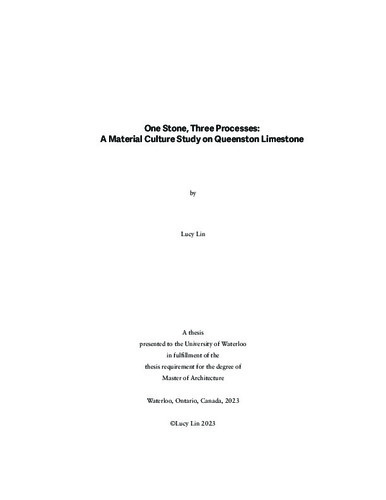| dc.description.abstract | Named after the Queenston Quarry, Queenston Limestone is Canada’s highest calibre of building stone for its durable building properties and aesthetics. The stone has been quarried in the St. David’s and Niagara region for over two hundred years. They were used in significant buildings and infrastructure in Canada such as the Ontario Parliament Building and the Grand Trunk Railway, earning their reputation as the “Corner Stone of Upper Canada”. Using Queenston Limestone as the vehicle, this thesis challenges the idea of materials as inert objects by revealing materials’ relationships with the built environment. Three themes are investigated to establish materials as active participants in the built environment. First, materials are positioned as part of assemblages, which are interrelated with other environmental elements. Second, the thesis emphasises material agency, which is materials’ power to influence and affect their surroundings. Third, materials’ involvement with human work shows how humans transform material while the materials shape human experiences.
One Stone, Three Processes: A Material Culture Study on Queenston Limestone interacts with Queenston Limestone through three processes: documenting and drawing the extraction site, learning and experimenting with traditional crafting techniques, and designing with discarded limestone. Part One, Landscape as Culture, involves a study of the Queenston Quarry through a series of drawings, diagrams and photographs, documenting the geological forces and human activities that influenced the development of the landscape over time. Part Two, Crafting Discards, includes three material experiments that study how traditional dry-stone stacking transforms Queenston Limestone and how Queenston Limestone enables the craft’s training environment. Part Three, Translating Materials, explores the designers’ role in working with materials by resonating with the complex material landscape of Queenston Quarry and foregrounding the intricate processes of stone craft. Through these three parts, this thesis explores the value of building materials, and reflects on the designers’ methods in studying and designing with materials. | en |

